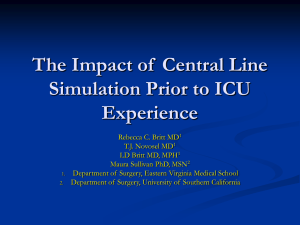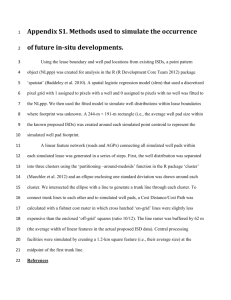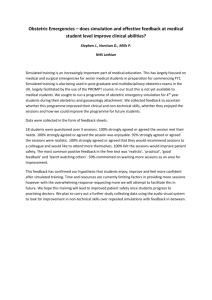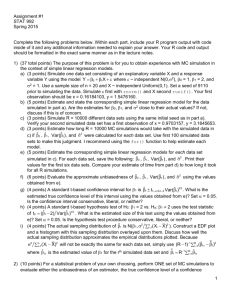Assessing the driving performance of older adult drivers: on
advertisement
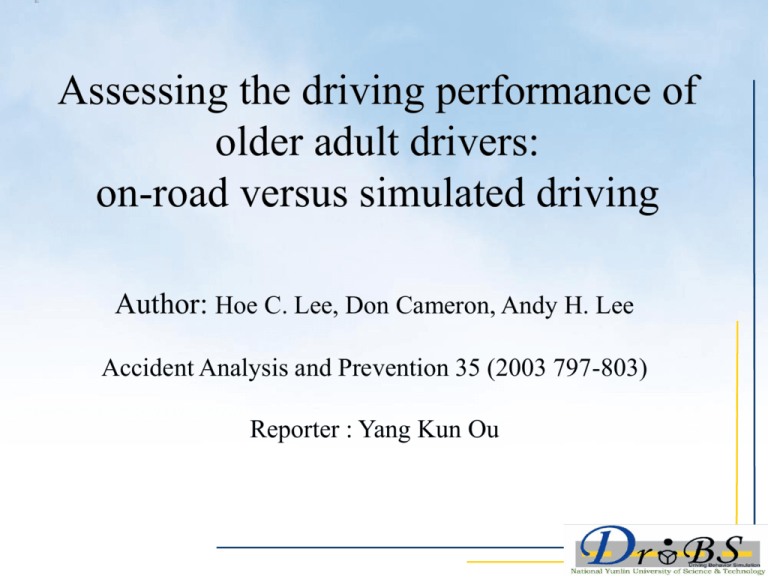
Assessing the driving performance of older adult drivers: on-road versus simulated driving Author: Hoe C. Lee, Don Cameron, Andy H. Lee Accident Analysis and Prevention 35 (2003 797-803) Reporter : Yang Kun Ou Purpose • To validate a laboratory-based driving simulator in measuring on-road driving performance • The results supported the validity of the driving simulator and it is a safer and more economical method than the on-road testing to assess the driving performance of older adult drivers Reference • Summala (1988) concluded that such measures are confounded by age, therefore, fail to reflect the actual cognitive and/or physical deficits of older drivers • Many studies have concluded that driving simulators can provide accurate observations on drivers’ behaviors and functions (Alicandri, 1994; Fraser et al., 1994; Van der Winsum, 1996; Desmond and Matthews, 1997; Ellingrod et al., 1997; Van der Winsum and Brouwer, 1997) Reference • Simulators have recently been used to study the driving behaviors of Alzheimer patients (Rizzo et al., 2001). Methods • Participants – Included 129 participants (78% is male ) – The sample age ranged from 60 to 88 years (mean = 72.9, S.D. = 7.1) – valid driving license and not having incurred five or more demerit points in the past 2 years Procedure • Assessment of each individual took approximately 2.5 hour – – – – orientation, 45-min simulated driving session 40 min of on-road testing post-assessment questionnaire survey Procedure • The STISIM driving simulator used to study the behaviors of the participants in a simulated driving environment. (Fig. 1.) • The simulator was programmed so that participants had to perform driving tasks involving different traffic scenarios, specially designed to investigate their road knowledge and cognitive/perceptual skills related to the known attributes of safe driving. Fig. 1. A participants being assessed by the STISIM driving simulator Procedure • A set of 10 simulated assessment criteria was developed to gauge driving performance • These desirable driving behaviors were defined with reference to the current licensing standard in Western Australia. Assessment criteria Description of the traffic scenarios and task required to perform by the participants Desirable driving behaviors (score). Road skills Rule compliance Double lanes road, where participant’s car was on the right lane. KEEP LEFT signs displayed every 50m to prompt participants to go back to the inner lane. TASK: Lane changing Follow “keep to left ‘’ rule; voluntarily (2) with visual prompt (1) check traffic by head turn (1) with rear mirror (1) proper use of indicators (1) Traffic sign compliance Driving through STOP, GIVE WAY and pedestrian crossings. TASK: drive through the scenarios safely Approach slowly (1) stop in right place (1) give way as required (1) proceed when opportunity comes (1) correct use of indicators (1) check mirror before proceed (1) Driving speed Double-lanes straight road, 60 km/h speed limit. TASK: drive 2 km along the road according to the designated speed Speed (2 km/run time of the distance) Use of indicator Road work blocking the road. TASK: drive around the obstacles and return to the inner lane as soon as possible Signal to the right and left to change lane (2, one each) check traffic (1) voluntarily return to inner lane (1) Road use obligation T-junctions leading to main road with STOP signs. TASK: observe traffic conditions and drive through safely Approach with caution and slow down (1) indicate right or left turn (1) proceed when has opportunity (1) check traffic with head turn (1) rear mirror (1) use of indicators (1). Assessment criteria Description of the traffic scenarios and task required to perform by the participants Desirable driving behaviors (score). Cognition/perceptual Decision & judgement Pedestrians 25m ahead running across the road hastily, car parking on the roadside move out without signalling and car in front suddenly slow down. TASK: avoid crashing One mark for each success in avoiding accident when confronted with simulated dangerous driving scenarios. Working memory Five street names and five manoeuvres (turn left or right) marked on a route of road map to a fictitious park. TASK: remember the names and the manoeuvres in 5 min and recall them after 10 min simulated driving Names and manoeuvres recalled (1 for each correct answer, up to 8) Sequence of manoeuvre (3, in perfect order; 2, 2–3 correct; 1, 1 correct and 0, none). Multi-tasks Fifteen billboards with “SUBSTRACT” sign were posted along the road. TASK: starting from 100, take away “5” every time the “SUBSTRACT” billboard comes out Correct answer (1) Confidence on high speed Speed limits (60, 70 and 110 km/h) vary according traffic conditions. TASK: observe and maintain a speed close to the speed limits Number of tokens received when the driving speed is close to the designated speed (±5 km/h) Attention task “Diamond” shapes on the top corners of simulator screen change to “triangle” randomly. TASK: engage the “turn” indicator in response to the visual stimulus Correct responses Procedure • On-road assessment criteria were devised to measure driving performance • The current licensing procedure and standard of Western Australia were adopted. Assessment criteria Observations of the participants Desirable driving behaviors (score). Road use obligation Driving manoeuvres in seven roundabouts Being certain of obligation, proceeded when has opportunity to do, gave appropriate signals, gave signal not too short or long, did not give wrong signal. Traffic sign compliance Manoeuvres through four pedestrian crossings, with a “10 km/h” speed control sign and a speed bump Was able to slow down in approaching the crossing, did not stop when it is not necessary, did not hit the speed bumps, gave way to pedestrians crossing and compiled with the 10 km/h rule. Traffic light Manoeuvres before and through traffic lights Did not stop in wrong position, did not stop when not necessary, did not start before signal turns green, did not proceed on amber when could have stopped safely, did not proceed on red signal, did not cross continuous white line and did not fail to notice lights. T-junction Manoeuvres before and through Tjunctions Did not approach intersection too slowly, did not brakes or swerves at last minute, did not approach intersection too fast, looked both ways in approaching intersection, did not proceed if way is not clear, proceeded when has opportunity to do, would give way (right hand rule), did not turn across oncoming traffic, did not swing too wide on corner, did not cut corner, did not swing too wider on corner and did not turn across oncoming traffic. General driving skill The steering and breaking behaviour throughout the assessment Did not perform erratic movement of the steering wheel, did not put arm and elbow out of window, did not allow steering wheel to self centre, did not incorrectly position of their hand, did not do unnecessary on hand drive, did not depress clutch before brake in high gear stopping, did not stop too far from given mark, did not stop too suddenly, did not stop too slowly in quick stop test and did not stall engine. Assessment criteria Description of the traffic scenarios and task required to perform by the participants Desirable driving behaviors (score). Normal driving General driving behaviour throughout the experiment Kept to left, drove with reasonable speed, did not drive on erratic speed, did not take erratic course, used rear view mirror frequently, did not exceeds speed limit, did not follow closely to the front car, did not overtake unnecessarily, did not over the centre line overtaking. Error detection Awareness and sensitivity of participants in finding out they had made mistakes Noticed in a wrong place at once, noticed in a wrong place until drive for more than 10 m, did not need to be told that a mistake had been made, checked traffic and rectified the mistake by doing a U-turn safely. Error recovery Driving behaviours when participants tried to rectify mistakes committed Did not do a hasty U-turn without observing the traffic, knew what to do and require no verbal prompting to rectify the error, checked other traffic by turning head, signal to indicate intention in about turn, looked to rear either directly or in mirror. Use of indicator Correct use of indicators throughout the assessment One point for each correct use of indicators. Driving speed Speed of the car driving through a 500m segment of straight road (70 km/h) The distance divided by run time Working memory Participants’ ability to remember the test route One point was deduced if participant ask for directions Ethical considerations • Written consent was sought throughout the process and confidentiality of records was maintained. • All participants were informed that they were free to terminate the study at any time without any negative consequences Result • Driving information – Of the 129 participants, 70% wore spectacles during the assessment – Approximately 12% of the participants had been employed in occupations which involved driving a vehicle regularly, such as courier workers, taxi or truck drivers, prior to retirement. – The estimated driving time per week ranged from 1 to 35 h (mean = 11, S.D. = 8.35) Result • Eleven participants (9%) reported a mild degree of dizziness after completing the simulated driving assessment. • Such feeling of dizziness only lasted for a short time and did not appear to affect the subsequent on-road test Analysis of simulated driving and road assessment criteria • The measurement properties of the assessment criteria were examined by reliability analysis • The Cronbach alpha coefficients were 0.7 and 0.8 for simulated driving and on-road driving variables, respectively, confirming the internal consistency of the scales that comprise the two measures of driving performance. • An inspection of Pearson correlations revealed that the assessment criteria were highly correlated within each setting, with r as high as 0.8 between some variables Analysis of simulated driving and road assessment criteria • Simulated Driving Index = −0.26 attention task − 0.38 rule compliance −0.36 road use obligation −0.38 decision and judgement −0.36working memory − 0.40 use of indicator −0.21 multi-tasks − 0.18 driving speed −0.14 confidence on high speed −0.36 traffic sign compliance Analysis of simulated driving and road assessment criteria • Road Assessment Index = 0.28 error detection + 0.15 error recovery +0.36 general driving skill + 0.3 normal driving +0.39 road use obligation +0.27 traffic sign compliance +0.22working memory + 0.39 use of indicator +0.31 driving speed + 0.36 T-junction +0.16 traffic light Relationship between the performance indices • the Simulated Driving Index was positively associated with the Road Assessment Index, with r = 0.716. • Over 65.7% of the variability in the Road Assessment Index can be explained by the Simulated Driving Index, after accounting for age and gender, though the latter appeared to be non-significant. Plot of road assessment index against simulated driving index Relationship between the performance indices


